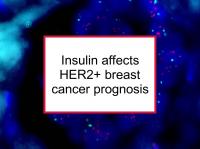Up to 25% of breast cancers overexpress the HER2/neu gene, which has a role in pathways leading to cell growth and differentiation. Obesity has been linked to worse outcomes women with HER2+ disease — both overall survival and time to progression have been reported to decrease with increasing body mass index (BMI) among such patients.
Leptin, a hormone correlated with excess fat, increases HER2 stability, and can impair response to treatment with trastuzumab (Herceptin). There is some evidence, however, that the risk of HER2+ breast cancer is heightened by type 2 diabetes even in the absence of obesity. Type 2 diabetes is characterized by insulin resistance and high circulating insulin levels. HER2, insulin, and insulin-like growth factor I (IGF-1) receptors are all involved with the same signaling pathway.
Type 2 diabetes has also been found to be associated with poor survival of women with stage 2 or higher HER2+ breast cancer. Use of the anti-diabetic drug metformin is associated with better prognosis among women with HER2+ breast cancer. Now a new study has reported that high circulating insulin levels increased both tumor size and number of lung metastases in a mouse model of HER2+ breast cancer.
Latest research finds insulin promotes HER2+ tumor aggressiveness
The study referenced at the beginning of this news story was designed to investigate how elevated circulating insulin levels influence tumor growth and metastasis in a mouse model of HER2+ breast cancer. To conduct the study, the authors crossed hyperinsulinemic (MKR+/+) mice with NeuNT (MTB/TAN) mice to produce MTB/TAN/MKR+/+ mice. These MTB/TAN/MKR+/+ mice and a group of MTB/TAN mice that served as controls mice were administered doxycycline (an agent known to induce NeuNT mammary tumor (HER2+) formation). Tumor tissues were removed and examined at two, four and six weeks after tumor initiation.
The MTB/TAN/MKR+/+ mice developed greater tumor mass than the controls, and this was associated with higher phosphorylation of the insulin receptor (IR)/insulin-like growth factor receptor 1 (IGF-1R). This finding indicates that activation of these receptors in the presence of excess circulating insulin could promote growth of mammary tumors. After 12 weeks, although no further additional tumor weight was seen in the MTB/TAN/MKR+/+ mice, the number of lung metastases (16.41 on average) was significantly higher in MTB/TAN/MKR+/+ mice compared to controls (5.36). The authors conclude that high circulating insulin in MTB/TAN/MKR+/+ mice resulted in larger, more aggressive mammary tumors, with more numerous lung metastases.
Please see our articles on HER2+ prognosis and type 2 diabetes for more information.
